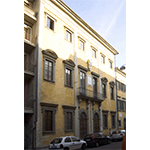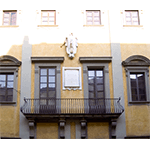Domus GalilŠana
Instituted in 1941 with the purpose of collecting and preserving bibliographical and documentary sources on Galileo and his followers, the Domus Galilaeana conserves a rich library of some 40,000 titles, between volumes and pamphlets, and a precious nucleus of Galilean manuscripts and documents received on deposit from the University Library. For their value and uniqueness, we cite an autograph letter by Galileo Galilei to Fra’ Paolo Sarpi containing the first formulation of the law of falling bodies (1604), various iconographical materials concerning the Pisan scientist, the archive of the inventor of the dynamo Antonio Pacinotti, the papers of Antonio Favaro, curator of the monumental national edition of the works of Galileo (1890-1909), and the notes left by physicist Enrico Fermi at the time of his departure for the United States.
The Domus is headquartered in the rooms remaining of the old Observatory of the University of Pisa, the first public astronomical observatory of Tuscany and among the oldest in Italy, the construction of which began in 1734. It was situated in a five-storey tower that had been built over the remains of an older one on one side of the building. In 1739, a chair in astronomy was instituted at the University of Pisa and entrusted to Tommaso Perelli, who was also appointed director of the Pisan Observatory. Due to various difficulties, principally of a financial nature, the astronomical activity proper began only in 1846. As of 1765, Perelli could avail himself of the help of Giuseppe Antonio Slop de Cadenberg, who was later to take his place as director. Slop de Cadenberg began a regular observation activity and attended to the publication of six volumes of astronomical studies conducted in Pisa. Between the 18th and 19th centuries, Giuseppe Piazzini too, worked at the observatory, and successfully committed himself to renewing the instruments, though he was not successful in obtaining the longed-for creation of a new astronomical headquarters. In 1826, due to its precarious stability, the old astronomical tower was demolished. The Specola of Florence and the Ximenes Observatory thus remained the only astronomical centres active in Tuscany.
****************************
Texts by Graziano Magrini
English translation by Victor Beard
Last update 24/gen/2008





